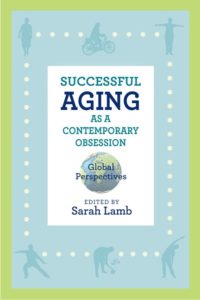Reviewed Book
Successful Aging as a Contemporary Obsession: Global Perspectives, Sarah Lamb, ed., New Brunswick, NJ: Rutgers University Press, 2017, 266 pp.

With the edited volume Successful Aging as a Contemporary Obsession, Lamb and colleagues provide a welcome contribution to the anthropology of aging and the life course, a generous blend of critique, ethnographic vitality, and alternative imaginings. Organized around four sections—Gender, Sexuality, and the Allure of Anti-aging; Ideals of Independence, Interdependence, and Intimate Sociality; National Policies and Everyday Practices; and Medicine, Morality, and Self—the book offers valuable insights into the experience of growing older in a contemporary moment increasingly saturated by the successful aging paradigm.
The volume presents itself as a corrective to the dominance of successful aging as a way of envisioning and living the latter half of the life course. As a paradigm, successful aging approaches aging as a normative project of activity and engagement, sustained throughout later life, that older adults ought to zestfully embrace. While, as readers are told, the original vision of successful aging’s most recognized champions, Rowe and Kahn, was to “counter ageism and the negative discourse of decline” (Calasanti and King, p. 27), their programmatic focus on (1) avoiding disease and disability; (2) maintaining physical and mental functioning; and (3) active engagement has resulted in an ethos of aging that aligned all too well with the increasingly dominant biopolitical ethical imperative of personal responsibility for one’s health. Lamb’s volume takes as a starting point an understanding that successful aging is but one way to consider the life course’s latter half.
While the critique of successful aging’s neoliberalizing tendencies has begun to be levied elsewhere, the real strength of this volume is its ethnographic evidence, which not only elucidates the ideologies that undergird the paradigm by demonstrating their effect on people’s lives but also presents alternative, localized conceptualizations of aging. Readers are invited to consider the influence of successful aging from various vantage points, such as the gendered nature of the successful aging paradigm and the experience of growing older (Calasanti and King; Brooks), intersectional stigma felt by aging African American lesbians and gay men (Woody), eroding repercussions of colonialism on gerontocratic societies (McIntosh), structural inequalities home health workers experience as they provide the hidden labor that sustains older adults’ “independence” (Buch), shifting understandings of who “heroically” maintains the personhood of those with dementia (Leibing), and the tensions around friendship that successful aging engenders among older adults whose social relations are not aging as “successfully” as the paradigm demands (Taylor).
The European variant, “active ageing,” is explored in Danish and Polish instantiations, which underscore how state-level sponsorship of programs shape the possibilities of aging, both for those who engage them and those who resist or rework them (Lassen and Jespersen; Robbins-Ruskowski). Alternatives to the paradigm of successful aging are offered as older adults differently understand and embrace the changes that accompany aging, from an approach of “foolish vitality,” the “playful, unashamed, acceptance of old age, wrinkles and all” (Danely, p. 157) to “comfortable aging” and “meaningful decline” as ways to reconceptualize the biological realities of aging bodies and their implications (Loe; Lamb). Readers encounter older men who eschew biomedical intervention to maintain youthfulness (Wentzell), the Chinese notion of yangsheng, or “nurturing life” (Farquhar and Zheng), and the experiences of aging nuns, whose often high cognitive functioning late into old age has long been recognized as exceptional within the medical community (Corwin). As rich, situated portraits of aging accrete across chapters, the reader is invited to consider that “the contemporary paradigm of successful aging is not the only way, nor necessarily the best, most humane, or most inspirational way, to imagine aging and what it means to be human” (Lamb; Robbins-Ruskowski; Corwin, p. 1).
Successful Aging’s breadth is impressive, especially for a volume of 250 pages. If there were one inclusion that I would have liked to see, however, it would have been a chapter on aging and disability. The experience of growing old as a disabled person is less visible in the anthropological corpus. And while scholarship on aging and disability studies have, at times, had a complicated relationship, the normative force of successful aging seems ripe for engagement from a disability studies perspective.
As a teaching resource, the volume is well suited for upper-level undergraduate anthropology courses, as well as graduate-level introductions to the anthropology of aging across the social sciences, gerontology, and public health. Chapters are concise and incisive, able to stand on their own but also contributing to an overall landscape of the successful aging paradigm. The centrality of contributors’ ethnography makes it an ideal provocation for students to recognize the strangeness of familiar conceptions about aging (Lamb; Robbins-Ruskowski; Corwin, p. 17). As the book is fairly evenly split between material from the United States and chapters focused elsewhere, including Mexico, Poland, Denmark, Japan, China, Ghana, Brazil, and India, it illustrates successful aging’s seductive sway and also maps a variegated terrain of lived experience. Those chapters set outside the United States in many ways act as foils to successful aging as it unfolds within it, places and experiences from which to call into question the foundations of successful aging, witness its increasing circulation and influence, and suggest alternative aging visions. Further, the ethnography makes the volume’s chapters useful as means to engage students in conversation about—and illustrate the theoretical foundations of—the life course, political economy, morality and ethics, personhood, care, and interdependence on which they are built.